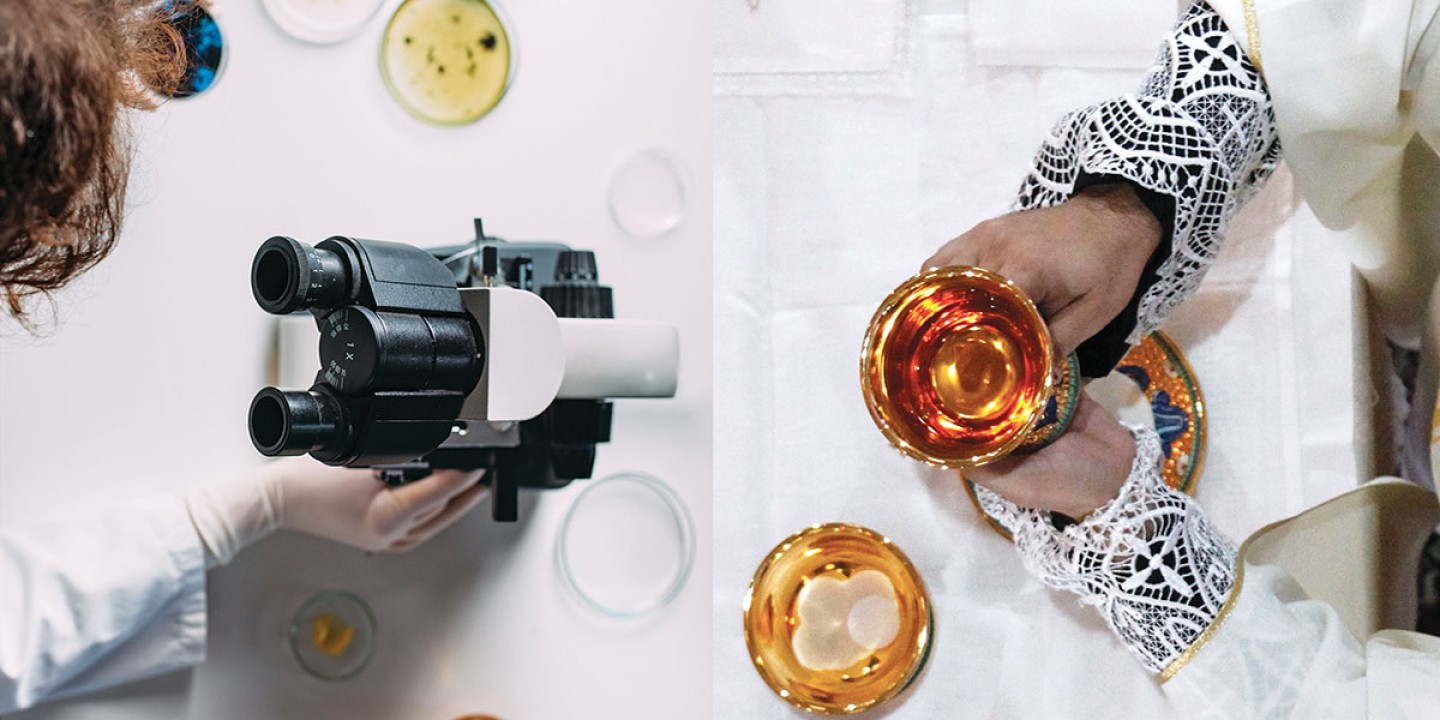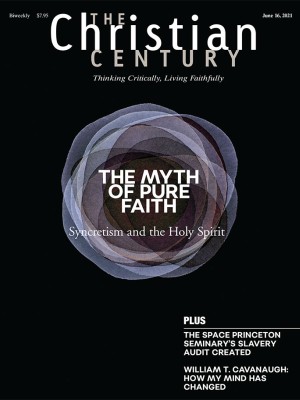Where my faith and my work as a scientist meet
It’s difficult to study the phylogenetic tree and still feel lonely.

Thursday mornings, I’m the first one in the lab. The room never sleeps. I enter to the hum of –20° freezers, eerie blue light from the ultraviolet hood, the whir of thermocyclers digesting DNA. I turn on the lights, don purple latex gloves, and begin.
Sometimes I extract genes: clip the pectoral fin from an ethanol-preserved fish, dissolve it with enzymes, and incubate it in a bath of reagents. Other times, I run gels or perform PCR or write program code on the lab computer. The skills are second nature. My work has a meditative flow of clicking pipettes and spinning centrifuges and endless streams of specimen IDs.
Read our latest issue or browse back issues.
Shortly after ten, I peel off my gloves and walk up the hill to Yale Divinity School. Dozens of people gather in Marquand Chapel for morning worship—worship, that is, in its most flexible and creative sense. We sing in English, but also in Spanish and Xhosa and Hebrew and Portuguese. We pray, but this means raising our hands or walking in circles or reciting poetry or, if you’re so moved, speaking in tongues. The service includes traditional Christian liturgy, too: the Nicene Creed, Anglican hymns with organ music, the chromatic melodies of eucharistic prayers. It feels like we’re performing religious liturgy the way it was always meant to be done: using traditions as a starting point to express the very real joys, sorrows, and prayers of a diverse living community. It’s vibrant, experimental, and unifying.
Vibrant. Experimental. Unifying. These three words could just as easily describe my experience of laboratory or chapel. Many other words, too, belong equally in both places. Curiosity. Contemplation. Tradition. Questions. Pattern. Wonder. Discovery. Awe.
This is why I have a hard time when I’m asked, as I often am, to justify the relationship between my work as a biologist and my faith. People in multiple realms assume that science and faith are inherently at odds; it’s shocking to try to unite them. I’m not interested in debate. I believe the relationship between science and religion is much more nuanced, and that the two realms overlap constantly.
For example, they meet in response to global problems—the need to mobilize religious ethics to respond to resource inequity and climate injustice. They also meet in individual human beings—in scientists who identify with some form of faith, for whom the practice of one way of knowing reciprocally informs the other.
I’m one of those scientists. A marine biologist and a chapel-goer, a National Science Foundation fellow and a student of theology, a species discoverer who is in divinity school to become a priest. The vocabulary of my faith and the vocabulary of my science have evolved hand in hand. Neither is complete without the other. Through images, metaphors, details, and stories, science allows my faith to take vivid and personal form.
In Man Is Not Alone, Abraham Joshua Heschel writes about the twofold calling of human beings. “Citizens of two realms, we all must sustain a dual allegiance: we sense the ineffable in one realm, we name and exploit reality in another.” In a simplistic telling, the ineffable belongs to religion, and reality belongs to science. In my experience, both disciplines exist on a spectrum between these two dimensions of being. We need a language that speaks to the porousness between science and religion, the way the words and stories of each can share room in our hearts and our minds and joyfully inform one another.
As I traverse the path between chapel and lab, inhabiting both spaces and observing what I feel and find, I know that I am looking for what John O’Donohue called a “nest of belonging,” a place where all of me is met and connected in relationship. At its simplest, my faith stems from a desire to belong. I turn to God to transcend my small self, connect with others, and recognize my identity in the web of all being.
At its simplest, my pursuit of science comes from the same calling: a longing to elucidate and experience relationship. I seek, as O’Donohue writes, a detailed understanding of “the great tapestry that connects everything everywhere”—the web of life.
Consider the definition of ecology: it’s the branch of biology that deals with the relationships between living things and their physical environment. Ecology investigates the flux of matter and energy through systems and the infinite interactions that characterize this exchange. Evolution, too, is all about relationship. Think of a phylogenetic tree—a circular, all-encompassing figure showing the branching links between every group of creatures. It’s difficult to spend a lifetime studying these things and still feel lonely.
The practice of science, for me, is a kind of communion. I realized this one morning in Marquand Chapel, when I joined the Eucharist after a shift in the lab. The whole community held hands and sang and passed around bread and wine.
Wine is 85 percent water. These same drops of H and O have existed since the start of creation, cycling through clouds and oceans and streams and bodies. Bread is made from biomolecules, complex chains of carbohydrates—Cm(H2O)n—and nutrients like calcium, phosphorous, and iron. These molecules are hewn from the earth, cycled from rock to sand to soil to biomass. When you eat, these minerals assimilate into your bones and blood, constantly rebuilding and restructuring your inner architecture. Each bite of bread becomes an affirmation of union. Through the ritual of breaking bread, we teach our bodies that we belong.
Franciscan scholar Cynthia Bourgeault writes, “To see God in others means to realize that the whole and the part live together in mutual, loving reciprocity. . . . We are simply two cells of the one great Life.” It’s one thing to recite “We are all living parts of one body” in the rhythm of eucharistic prayer. It’s another thing to taste and touch this union, through the crumbs in your mouth and the held hands of others, while also glimpsing the entire chain of matter and energy and evolution that led to this moment and the cascade of bonds and interactions that will continue on.
It’s science that gives me this sweeping perspective—at once wide, microscopic, unifying, particular, and deep. It’s faith that moves me to call this experience God.
A version of this article appears in the print edition under the title “Lab and chapel.”





